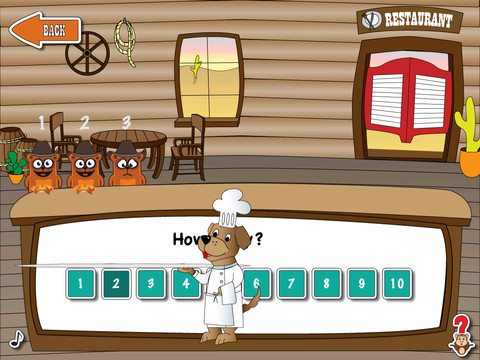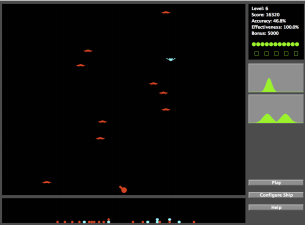Critter Corral
To help preschoolers develop a flexible understanding of number, we created Critter Corral, a freely available iPad app. The child's goal is to help return a Wild West town to its former glory by helping the town's businesses. In all games, the task is to create a 1:1 correspondence with a target amount.

Teachable Agents
Teachable Agents (TA) is a learning technology that draws on the social metaphor of teaching a computer agent to help students learn. Students teach their agent by creating a concept map that serves as the agent's "brain." An artificial intelligence engine enables the agent to interactively answer questions posed to it by traversing the links & nodes in its map. As the agent reasons, it also animates the path it is following, thereby providing feedback, as well as a visible model of thinking for the students. Students can then use the feedback to revise their agent's knowledge (and consequently, their own).
Choice-Based Assessments: Idollet
In this game-based assessment, players combine different lights to make specific colors shine during the animals' musical performances. Players are required to think critically about resources in the game to help them understand additive color mixing. Using this assessment, we found that students' choice to engage in critical thinking to learn about the primary colors of light predicted 35% of the variance in their mathematics grades.
Stats Invaders
We designed a simple computer game called Stats Invaders. The game is modeled loosely after the arcade classic Space Invaders, but with the twist that the aliens are dropping from the sky according to a probability distribution. Your task is not simply to shoot the aliens, but also to determine which of two displayed distributions (normal or uniform). is generating the alien attack.

R2
Rate-and-Relate (R2) tries to facilitate safe conversations about the values that people hold dear, so people can come to understand one another and learn more effectively. It is primarily intended for teachers and their classrooms, but it can be used in many other settings. In the typical use, a teacher creates a prompt, for example, "What is the most important goal of this class?" The teacher provides five possible alternatives, for example: (a) to learn a few big ideas, (b) to get a good grade, (c) to explore one's interests, (d) to master all the content, (e) to be the very best student.

Working on-line individually, students and the teacher each sort the five alternatives from most important to least important (to them). The next step is the key twist that makes R2 effective for safe conversation. The students need to predict how the teacher ranked the alternatives, and the teacher needs to predict how the students ranked the alternatives.
